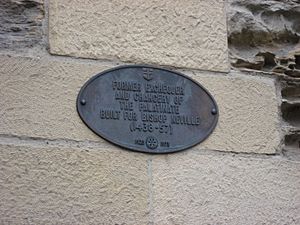County palatine facts for kids
A county palatine or palatinate was a special area in England, Wales, and Ireland. It was ruled by a powerful nobleman, like an earl or a duke, who had unique authority. This nobleman could govern the county almost like a king, with a lot of freedom from the actual king.
The word "palatine" comes from the Latin word palātīnus, meaning "relating to the palace." This shows that the ruler of a county palatine had powers similar to those of a king in his own palace.
These special counties were often created in areas on the edge of a kingdom. These were places where there was a risk of attacks or rebellions. Giving a local lord strong, independent power helped them quickly organize defenses without waiting for orders from the king. Since this power was passed down through families, some counties palatine continued to exist for a long time, even after the reasons for their creation were gone.
Contents
History of Palatine Counties
How Palatinates Began
Palatinates started appearing in England after the Norman Conquest. The king gave certain earls or bishops "palatine" powers. This meant they could do things that the king normally did, like organize defenses or manage local laws. This was especially helpful in border areas, allowing local leaders to act quickly. However, palatine powers were also given to areas not near borders, like the Isle of Ely.
Famous English Palatinates
Chester: The Prince's County
The earls of Chester gained palatine powers over Cheshire. Since 1254, the title of Earl of Chester has usually belonged to the heir apparent to the throne (the person next in line to be king or queen). Chester even had its own local parliament and was not represented in the main English Parliament until 1543. It kept some of its special rights until 1830.
Durham: The Bishop's Powerhouse
The bishops of Durham were given extraordinary powers. After the Norman Conquest, they were put in charge of running the area that became County Durham. The bishops of Durham had a lot of independent power, which lasted a very long time. Durham did not get to send representatives to Parliament until 1654. The bishops kept their special ruling powers until 1836.
Lancaster: The King's Own Duchy
Palatine powers over Lancashire were given to the first duke of Lancaster in 1351. This was only the second dukedom created in England. When Henry IV became king in 1399, the Duchy of Lancaster became part of the Crown. However, the huge lands of the Duchy of Lancaster were never fully joined with the king's other lands. Even today, they are managed separately for the monarch, who is known as the Duke of Lancaster. The special palatine powers over Lancashire, managed through the Duchy, lasted until 1873. In Lancashire, people still toast "the King, Duke of Lancaster."
Until the 1800s, the king's official orders did not apply directly in these three palatine counties. Also, until the 1970s, Lancashire and Durham had their own special courts for certain legal matters.
Other Palatine Areas
Over time, other areas also had palatinate status. These included Shropshire, Kent, the Isle of Ely, and Hexhamshire in Northumberland. In Wales, the Earldom of Pembroke was a palatinate until 1535.
While not officially called a palatinate, Cornwall had many similar rights given to the Duke of Cornwall. This title was created in 1337 and is always held by the heir apparent to the throne.
In Ireland, there were several palatine districts. The most well-known were those of the Earls of Desmond and the Earls of Ormond in County Tipperary. The Tipperary palatinate lasted until it was ended by a law in 1715.
In Scotland, the earldom of Strathearn was identified as a county palatine in the 1300s. However, its status did not seem very different from other Scottish earldoms.
Even in the colonies, some areas were granted palatine status. This included the historic Province of Avalon in Newfoundland and Maryland in America.
See also
- Marcher Lord—a similar type of powerful lord in the Middle Ages.
- Margrave—another similar type of lord in Europe.
- Duchy of Lancaster
- Justice of Chester




